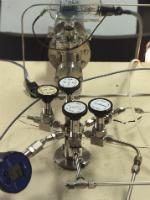Solar Photocatalysis

Artificial photosynthesis to create solar fuels – this is the breakthrough technology developed at CET by Professor Greg Metha and his research team.
Their novel technique combines two ideal virtues – carbon neutral solar energy harvesting and storage as well as reduction of atmospheric CO2.
The system
The team are using novel catalysts to carry out solar-induced photocatalytic conversion of carbon dioxide (CO2) and water (H2O) into methanol and methane fuels. A type of artificial photosynthesis, the process uses titanium dioxide (TiO2), an inert and abundant photo-active substrate.
The researchers have improved the catalytic performance of well-known and studied reactions. Their novel co-catalyst is made of nanoscale gold clusters embedded into TiO2 and is up to 40 times more efficient than the same quantity of traditional platinum catalysts. Similarly, by using nanoparticle ruthenium catalysts embedded into TiO2 the team were able to produce a mixture of methanol and methane at 80°C – significantly lower than the 200–250°C required by current commercial catalysts.
Applications
Using a simple, purely chemical approach to creating solar fuel has many advantages compared to other solar conversion methods. The process is space-efficient, scalable and can be built anywhere in sunlight.
